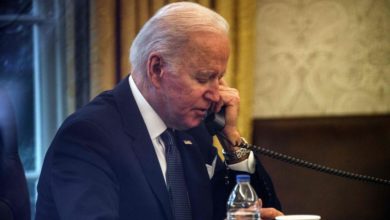Pope Francis Visits Indigenous Residential School Survivors

Brian Normand spent only a couple years—between the ages of five and six—at St. Charles Day Residential School in Manitoba, Canada, in the early 1960s, but he still feels the effects of that experience decades later.
“I was emotionally, physically, and mentally abused there. I left with a broken spirit,” the now-65-year-old tells TIME in a recent Zoom conversation from Winnipeg.
Holding an Eagle feather that, for him, represents truth telling, he recalls how staff members called him a savage, hit him with a yardstick and smacked him across the head if he spoke Michif, the language of the Métis Nation. He would then lash out at others for years and eventually had to learn how to manage his anger. Whenever he hears news coverage of the topic, feelings of anger return and “I hold my fists and cry.”
Normand, however, has discovered healing in sharing his experiences with family and friends. Pope Francis is expected to take the stories from survivors to Canada during the week-long visit.
The Pontiff will travel to Canada on Sunday for a week-long tour of the country on what he has described as a “pilgrimage of penance.” He is expected to issue a wider apology for the Catholic Church’s role in running Indigenous boarding schools throughout the 19th and 20th centuries.
“Unfortunately in Canada many Christians, including some members of religious orders, contributed to the policies of cultural assimilation that in the past gravely damaged native populations in various ways,” Pope Francis said last Sunday.
To Normand, the Pope’s apology and Canada trip is “unbelievable.”
“It’s an important first step. Survivors like myself have been waiting generations for this apology,” he says. “This apology is an important acknowledgement of pain and suffering and hurt we have experienced and continue to live through. I believe it’s a sign of better things to come. We will rise above the hurt and the pain and be strong.”
It’s estimated that more than 150,000 children attended these schools, which aimed to assimilate the Indigenous populations, from the 1880s to the 1990s, according to the National Centre for Truth and Reconciliation at the University of Manitoba. Although the exact number of Indigenous boarding school students that died isn’t known, it does indicate that there were at least 4,120 who either never returned home after their studies or who became ill at home and later died from complications.
“It was the intent of the system to erase Indigenous languages and cultures and break apart families,” says Jesse Boiteau, Senior Archivist at the National Centre for Truth and Reconciliation and a member of the Métis Nation. “What we’re seeing and understanding now is the lasting impacts and legacies of the residential schools, whether it be missing and murdered indigenous women and girls, whether it be the child welfare system, or the over-representation of Indigenous peoples in incarceration.”
The Pope’s visit comes more than three months after he apologized to a delegation of boarding school survivors at the Vatican for the “deplorable conduct” of “some Catholics” at Indigenous boarding schools. Canada’s Indigenous organizations hope the Pope will visit again next week.
Continue reading: Pope Francis on the Road
The Pope’s apology “didn’t accept the responsibility on the part of the institution, and that’s what people want now—that the Pope accept responsibility for the Roman Catholic Church,” says Jim Miller, author of Canada confronts its history with residential schools and reconciliation
The Pope’s expected apology in Canada is also taking place seven years after it was recommended by the Truth and Reconciliation Commission of Canada. 2015’s report contained 94 call to actions that were intended to address the grievances of those responsible and to urge policies to support First Nations communities still in poverty.
The delay in acting on the recommendations suggests the issue “obviously hasn’t been treated as high priority by the Catholic Church,” says Marie Wilson, a former commissioner on the Truth and Reconciliation Commission of Canada. “Tens of thousands of survivors have passed on since we’ve finished our work, and those people will not have the benefit of hearing an apology from the head of their church.”
Some also worry any apology won’t lead to meaningful change, says Ry Moran, a former member of the Truth and Reconciliation Commission.
One-third of Indigenous boarding school students were managed by the Catholic Church. Other schools were operated by Protestant orders. Kuper Island, British Columbia was one of the most notorious schools. There were 264 students who mysteriously perished at this school. At St. Anne’s in Fort Albany, Ontario, four former staffers “have been convicted on charges that include indecent assault, assault causing bodily harm, assault, and administering a noxious substance,” according to the National Centre for Truth and Reconciliation. The survivors say that the trauma they suffered from the schools had an impact on their psychological and emotional well-being for many years.
“From the church’s standpoint, the goal is to convert them to Christianity, to save their souls,” Miller says. “That’s what’s caused so much psychological and cultural damage.” Students struggled to support themselves, and the experience of the schools was so traumatic that family breakdowns, alcoholism, and premature death were common among victims.
Miller, who’s been studying Indigenous boarding schools since 1983, says he had never seen so much public attention to this issue until last year, when Indigenous groups announced the discovery of the remains of more than 1,000 children on sites of three former residential schools. At a time when the U.S. was continuing to experience its own national reckoning on race in the wake of George Floyd’s murder, news of the unmarked graves overlapped with this heightened awareness of racial injustice and got unprecedented attention in international headlines. “This week has opened the eyes of many Canadians,” Liberal politician Carolyn Bennett, then a Crown-Indigenous relations minister, said, “Like George Floyd did.”
The Canadian government has announced more funding to search potential unmarked graves in residential schools over the past year. To foster closer relationships with Indigenous communities, it introduced legislation creating an independent National Council for Reconciliation that is Indigenous-led. And it announced plans for a Residential Schools National Monument in Ottawa, the nation’s capital. Additionally, several indigenous groups renewed their calls for documents related to residential schools from the Vatican archives.
In light of Canada’s disturbing legacy, the U.S. has had to evaluate its own past. In May 2022, the U.S. Department of the Interior published its own review of federal Indigenous boarding schools that documented “rampant physical, sexual, and emotional abuse.”
Continue reading: The history of Native American Boarding Schools is more complex than the new research reveals
Experts in Indigenous Studies fear the momentum for further investigation has waned a year after the remains of Indigenous boarding schools were found on Canadian sites.
“There was this national reckoning last summer, but now we’re back to silence,” says Jennifer Brant, who is Kanien’kehá:ka and an assistant professor at the University of Toronto. Her grandmother attended the Mohawk Institute, an Anglican residential boarding school nicknamed the “Mush Hole” because of the rotten mushy food served there. The Pontiff’s apology makes her feel a lot of mixed emotions. “Will there be accountability and action behind this apology? Along with the mixed emotion, there’s a lot of skepticism. What’s going to be done?” she asks.
“What I hope is done is that we continue to have these conversations because there’s not just this intergenerational trauma or reality that we live with today, but like the intergenerational racist and sexist mindset that still exists in Canada, and that still places Indigenous peoples in spaces where they experience daily acts of racism. [That’s] something that I hope these conversations will start to change.”
Normand hopes the Pope’s visit will inspire other residential school survivors to be a part of these conversations and open up about their traumatic experiences more: “I know a lot of people don’t want to talk about it. I think it would be good healing for them to talk about it—not only for them, but for their family, their children, their grandchildren and for their community as well.”
Here are more must-read stories from TIME





